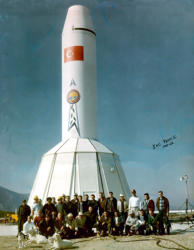
Jupiter SM-78 Weapon System
I&C Team 2, Çigli AB, Turkey 1961-1962 Chrysler Corporation Missile DivisionHISTORY - Page 29
Navy Requirements in the Development Program
When the Army and Navy actually began the development program, there were a number of problems to
overcome. These stemmed mainly from the reconciliation of requirements for the two services into a
single missile. Each had to provide for certain operational peculiarities. In this respect, whereas the Army
could handle a rather lengthy weapon, the Navy required a weapon as short as possible. The original Army
proposal was for a missile that was better than 90 feet high, and the Navy aimed for a 50-foot missile. This
called for a compromise, and a 58-foot weapon was decided upon. By going to the shorter length, a greater
diameter had to be invoked--105 inches—which caused some Army concern for logistics and transportation
reasons. Compromise between the two to gain respective goals became the key to the development mode.
In reality, Navy requirements played a rather heavy role in the system's design characteristics in view of
the peculiarities of launching a missile at sea: safety and adequate engineering for ship conversion. It was
necessary to design a complete set of launching and handling equipment for sea use as well as a set for
the land version of the missile. In all of these cases, technical coordination was required and the decisions
influenced configuration, so really ABM was engrossed in satisfying all requirements. General Medaris, in
November 1956, estimated that the decision on the length and diameter caused a design time loss of two
months, and another two-month loss to define several other Navy requirements. Yet, it was known that
the sea-based missile would be more complex than the land-based, for many of the latter’s requirements
had been resolved and proven
38
.
_____________________________
38. JUP Dev Plan, FY 1958, 29 Sep 56; Present by Maj Gen J. B. Medaris to the NSC, Dec 56; Draft, JUP Brochure forwarded to Chf, R&D, DA, c. Jan 57, Hist Off files.









HISTORY - Page 29
Navy Requirements in the Development Program
When the Army and Navy actually began the
development program, there were a number of
problems to overcome. These stemmed mainly from
the reconciliation of requirements for the two services
into a single missile. Each had to provide for certain
operational peculiarities. In this respect, whereas the
Army could handle a rather lengthy weapon, the Navy
required a weapon as short as possible. The original
Army proposal was for a missile that was better than
90 feet high, and the Navy aimed for a 50-foot missile.
This called for a compromise, and a 58-foot weapon
was decided upon. By going to the shorter length, a
greater diameter had to be invoked--105
inches—which caused some Army concern for logistics
and transportation reasons. Compromise between the
two to gain respective goals became the key to the
development mode.
In reality, Navy requirements played a rather heavy
role in the system's design characteristics in view of
the peculiarities of launching a missile at sea: safety
and adequate engineering for ship conversion. It was
necessary to design a complete set of launching and
handling equipment for sea use as well as a set for the
land version of the missile. In all of these cases,
technical coordination was required and the decisions
influenced configuration, so really ABM was engrossed
in satisfying all requirements. General Medaris, in
November 1956, estimated that the decision on the
length and diameter caused a design time loss of two
months, and another two-month loss to define several
other Navy requirements. Yet, it was known that the
sea-based missile would be more complex than the
land-based, for many of the latter’s requirements had
been resolved and proven
38
.
_____________________________
38. JUP Dev Plan, FY 1958, 29 Sep 56; Present by Maj Gen J. B. Medaris to the NSC, Dec 56; Draft, JUP Brochure forwarded
to Chf, R&D, DA, c. Jan 57, Hist Off files.





















